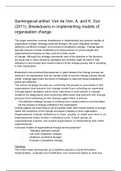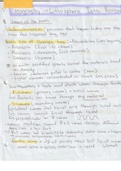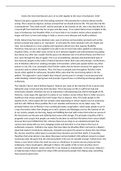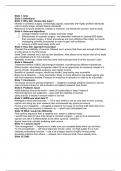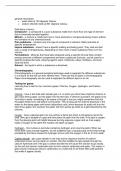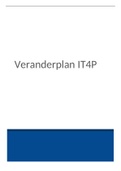Samengevat artikel: Van de Ven, A. and K. Sun
(2011), Breakdowns in implementing models of
organisation change
This paper examines common breakdowns in implementing four process models of
organization change: teleology (planned change), life cycle (regulated change),
dialectics (conflictive change), and evolution (competitive change). Change agents
typically respond to these breakdowns by taking actions to correct people and
organizational processes so they conform to their model
of change. Although this strategy commands most of the attention in the literature,
we argue that in many situations managers and scholars might do better if they
reflected on and revised their mental model to fit the change journey that is unfolding
in their organization.
Breakdowns are perceived discrepancies or gaps between the change process we
observe in an organization and our mental model of how the change process should
unfold. Change agent have two kinds of strategies to deal with these breakdowns:
action and reflection.
The action strategy focuses on correcting the people or processes in the
organization that prevent the change model from unfolding as expected.
Change agent→problem solver that intervene in and control a change
initiative by diagnosing and correcting difficulties that prevent the change
process from unfolding as the change agent think it should.
The reflection strategy focuses on revising one’s mental model to one that better
fits the process of change unfolding in the organization.
Change agents are more likely to be successful when their mental models of change
match the complexity of the change processes unfolding in their organization.
Organizational change→difference in form, quality, or state over time in an
organizational entity (entity= individual’s job, a work group, an
organizational subunit, the overall organization or relationship with other
organizations)
4 process models of organizational change and development:
- Teleology (planned change)
- Life cycle (regulatory change)
- Dialectics (conflictive change)
- Evolution (competitive change)
Teleology
This model views development as a repetitive sequence of goal formulation,
implementation, evaluation and modification of an envisioned based on what was
, learned or intended by the people involved. These processes break down because
participants do not recognize the need for change, they make erroneous decisions,
or they do not reach agreement on goals or actions.
These processes often fail because a minority of participants recognize the need for
change.
Fail when there is a lack of consensus on plan or goals among organizational
participants. Solution: socialization activities that provide a way of building
consensus
Fail due to faulty plans or goals because of biases in individual or group judgments –
errors in critical thinking and decision making. Solution: engaging other informants in
focus groups or brainstorming processes
Fail because of escalating commitments to failing courses of action
“Self-justification”: major reasons for escalation, individuals who are responsible for
an initial decision tend to become more committed to a failing course of action than
individuals not involved in the initial decision
Life cycle
This model depics the process of change as progressing through a
prescribed sequence of stages and activities over time. Activities in life
cycle model→ prescribed and regulated by natural, logical or institutional
routines. This is a model of passive compliance to mandated change by an
entity and also considers how proactive individuals adapt to their
environment and make use of rules to accomplish their goals.
Breakdowns are often by those who design and mandate a change routine.
Breakdowns happen when planners (who design a change program) are separated
from doers (who implement it but don’t participate in its development) because
learning fails when events are caused and consequences are felt by different people.
Solution: Reinvention facilitates adopting and implementing change programs, it is a
process of engineering and adapting a change to fit in a particular applied setting.
Breakdowns may reflect the complexity of most organizational changes as having
both positive and negative characteristics
Dialetic process theory
This theory explain stability and change in terms of the relative balance of
power between opposing entities. Change is generated through the
resolution of the conflict between the current thesis (A) and an antithesis
(Not A) which results in a synthesis (Not Not-A). Conflict→ core generating
mechanism of dialectical change. Dysfunctional methods of conflict
resolution→ impede dialectical change processes and may lead to
undesirable win-lose outcomes. Conflict also occurs when the opposing
parties have sufficient power to confront each other and engage in
struggle.
3 types of resolution methods:
(2011), Breakdowns in implementing models of
organisation change
This paper examines common breakdowns in implementing four process models of
organization change: teleology (planned change), life cycle (regulated change),
dialectics (conflictive change), and evolution (competitive change). Change agents
typically respond to these breakdowns by taking actions to correct people and
organizational processes so they conform to their model
of change. Although this strategy commands most of the attention in the literature,
we argue that in many situations managers and scholars might do better if they
reflected on and revised their mental model to fit the change journey that is unfolding
in their organization.
Breakdowns are perceived discrepancies or gaps between the change process we
observe in an organization and our mental model of how the change process should
unfold. Change agent have two kinds of strategies to deal with these breakdowns:
action and reflection.
The action strategy focuses on correcting the people or processes in the
organization that prevent the change model from unfolding as expected.
Change agent→problem solver that intervene in and control a change
initiative by diagnosing and correcting difficulties that prevent the change
process from unfolding as the change agent think it should.
The reflection strategy focuses on revising one’s mental model to one that better
fits the process of change unfolding in the organization.
Change agents are more likely to be successful when their mental models of change
match the complexity of the change processes unfolding in their organization.
Organizational change→difference in form, quality, or state over time in an
organizational entity (entity= individual’s job, a work group, an
organizational subunit, the overall organization or relationship with other
organizations)
4 process models of organizational change and development:
- Teleology (planned change)
- Life cycle (regulatory change)
- Dialectics (conflictive change)
- Evolution (competitive change)
Teleology
This model views development as a repetitive sequence of goal formulation,
implementation, evaluation and modification of an envisioned based on what was
, learned or intended by the people involved. These processes break down because
participants do not recognize the need for change, they make erroneous decisions,
or they do not reach agreement on goals or actions.
These processes often fail because a minority of participants recognize the need for
change.
Fail when there is a lack of consensus on plan or goals among organizational
participants. Solution: socialization activities that provide a way of building
consensus
Fail due to faulty plans or goals because of biases in individual or group judgments –
errors in critical thinking and decision making. Solution: engaging other informants in
focus groups or brainstorming processes
Fail because of escalating commitments to failing courses of action
“Self-justification”: major reasons for escalation, individuals who are responsible for
an initial decision tend to become more committed to a failing course of action than
individuals not involved in the initial decision
Life cycle
This model depics the process of change as progressing through a
prescribed sequence of stages and activities over time. Activities in life
cycle model→ prescribed and regulated by natural, logical or institutional
routines. This is a model of passive compliance to mandated change by an
entity and also considers how proactive individuals adapt to their
environment and make use of rules to accomplish their goals.
Breakdowns are often by those who design and mandate a change routine.
Breakdowns happen when planners (who design a change program) are separated
from doers (who implement it but don’t participate in its development) because
learning fails when events are caused and consequences are felt by different people.
Solution: Reinvention facilitates adopting and implementing change programs, it is a
process of engineering and adapting a change to fit in a particular applied setting.
Breakdowns may reflect the complexity of most organizational changes as having
both positive and negative characteristics
Dialetic process theory
This theory explain stability and change in terms of the relative balance of
power between opposing entities. Change is generated through the
resolution of the conflict between the current thesis (A) and an antithesis
(Not A) which results in a synthesis (Not Not-A). Conflict→ core generating
mechanism of dialectical change. Dysfunctional methods of conflict
resolution→ impede dialectical change processes and may lead to
undesirable win-lose outcomes. Conflict also occurs when the opposing
parties have sufficient power to confront each other and engage in
struggle.
3 types of resolution methods:

